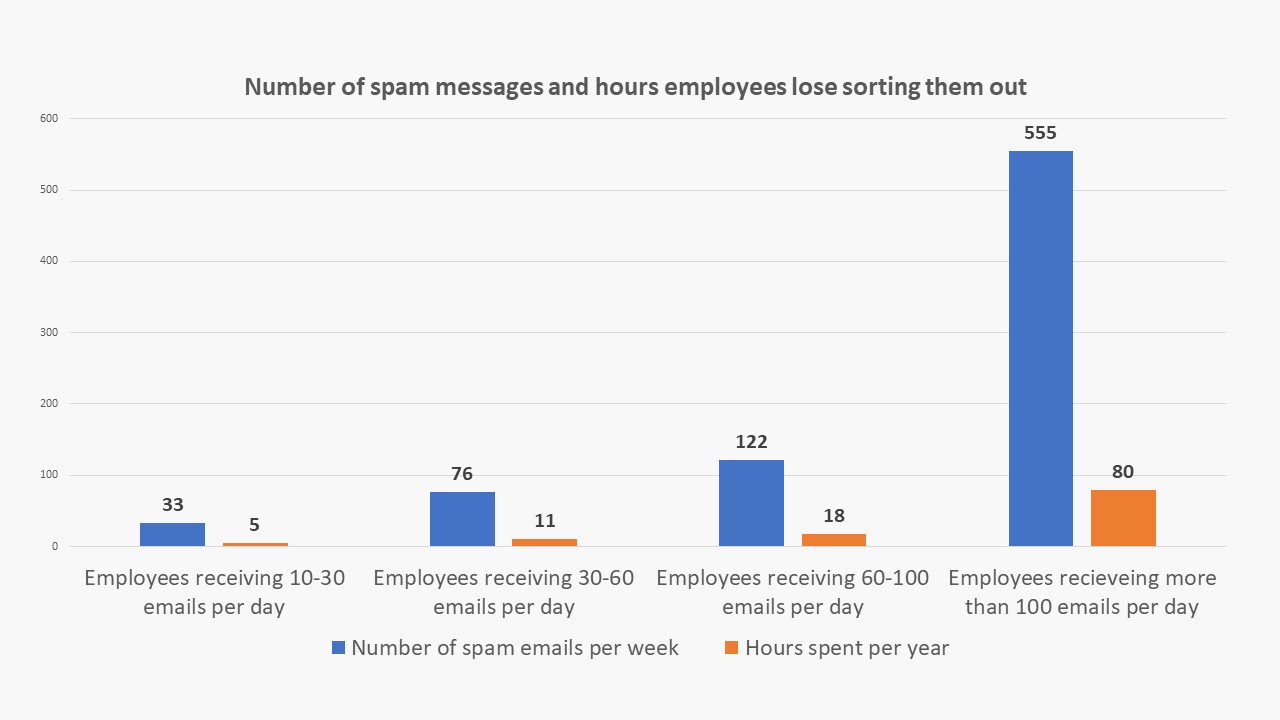Employees who receive 30-60 external emails per day could be wasting 11 hours every year looking through and identifying spam messages. For employees receiving between 60-100 emails a day, this number rises to 18 hours per year, which is more than two business days. These are the findings from Kaspersky’s analysis of the amount of spam bombarding corporate mailboxes and how it could affect the productivity of employees[1].
According to some third party estimates, 45%-85% of all emails generated each day are spam. But besides the lures, malicious links and attachments these emails may contain, the flow of spam can be annoying and overwhelming, clogging up user mailboxes if there is no anti-spam solution installed.
Kaspersky researchers analyzed the amount of spam received per employee and, using a third-party study,[1] approximated the number of hours office workers could be spending on reading or just looking through these messages. Employees were split into three groups according to the number of emails they received daily from outside their organization (emails from senders within the same organization were not counted).
According to the calculations, those getting sent up to 30 emails per day also receive around 30 spam samples a week, and waste in total around five hours every year sorting them out. Workers receiving 30-60 emails each day spend 11 hours per year doing the same, which is more than one business day. And those receiving up to 100 emails daily can spend 18 hours – more than two business days a year. For mailboxes with more than 100 incoming messages per day, the number of hours needed to sort out spam emails equates to 80 per year. But this could be general mailboxes for all incoming inquiries, which are usually not cleaned up.

“Five hours across a whole year may not sound critical for one employee. But when scaled to an organization with hundreds of employees, this may turn into a sizable amount of person-hours. The number may look greater in businesses focused on providing services where employees communicate more actively with external parties. Employees can also waste time getting back to work after reading and deleting spam, as email is a huge distractor. These negative effects of spam may not be so obvious, but organizations should be aware of them and protect their employees with dedicated anti-spam and anti-phishing tools,” comments Andrey Kovtun, Email Threats Protection Group Manager at Kaspersky.
To keep employees’ productivity high and avoid the negative consequences of spam and email threats, Kaspersky recommends organizations take the following steps:
- Switch on the anti-spam or junk email function in your mail service if there is no dedicated solution as an add-on. This feature should decrease the spam flow.
- Educate employees to recognize spam and especially phishing emails by looking at such signs as the sender's address, executable files or files with macros in attachments and calls to action. This should decrease the chance of an attack and help employees get rid of unwanted messages quicker.
- Implement dedicated protection for mail servers, such as Kaspersky Security for Mail Server with a solid set of anti-phishing, anti-spam, and malware detection technologies. For cloud services, such as Microsoft 365, there is a dedicated Kaspersky Security for Microsoft Office 365 solution.
[1] Spam statistics were obtained using Kaspersky Security Network (KSN), a distributed infrastructure that works with various anti-malware protection components. The statistics consist of depersonalized metadata voluntarily provided by KSN participants among Kaspersky customers. Further study conclusions are approximate and based on the analysis of data on the amount of time spent reading emails from a third-party source (“2021 State of Email Engagement” study by Litmus) and Kaspersky expertise.
[2] Study by Litmus “2021 State of Email Engagement”
